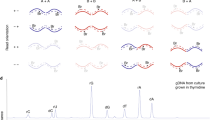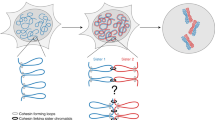Abstract
Rowley and Bodmer1 reported that the centric regions of quinacrine-treated mouse chromosome preparations show less fluorescence intensity than the remainder of the chromosome. They argued that because these centric regions contain a type of DNA that is richer in AT base pairs than unique sequence DNA, they would be expected to show diminished fluorescence according to the model proposed by Caspersson et al.2, according to which localised quinacrine fluorescence was attributed to the preferential binding of quinacrine mustard to the N-7 position of guanylyl residues in DNA. Thus, one would expect a relative paucity of guanylyl residues in the DNA of the centric regions to be associated with diminished fluorescence. It has since been shown3,4 that enhanced quinacrine fluorescence is due to AT base pairs, and studies of a series of GC-containing DNA polymers indicated that GC base pairs (or G alone) actually quenched fluorescence4. These observations did not explain why the centric regions of mouse chromosomes with their relatively greater abundance of AT base repairs show diminished quinacrine fluorescence.
This is a preview of subscription content, access via your institution
Access options
Subscribe to this journal
Receive 51 print issues and online access
$199.00 per year
only $3.90 per issue
Buy this article
- Purchase on Springer Link
- Instant access to full article PDF
Prices may be subject to local taxes which are calculated during checkout
Similar content being viewed by others
References
Rowley, J. D., and Bodmer, W. F., Nature, 231, 503 (1971).
Caspersson, T., Farber, S., Foley, G. E., Kudynowski, J., Modest, E. J., Simonsson, E., Wagh, U., and Zech, L., Expl Cell Res., 49, 219 (1968).
Ellison, J. R., and Barr, H. J., Chromosoma, 36, 375 (1972).
Weisblum, B., and de Haseth, P. L., Proc. natn. Acad. Sci. U.S.A., 69, 629 (1972).
Caspersson, T., and Zech, L., Hosp. Pract., 7, 51 (1972).
Author information
Authors and Affiliations
Rights and permissions
About this article
Cite this article
WEISBLUM, B. Why Centric Regions of Quinacrine-treated Mouse Chromosomes show Diminished Fluorescence. Nature 246, 150–151 (1973). https://doi.org/10.1038/246150a0
Received:
Issue Date:
DOI: https://doi.org/10.1038/246150a0
This article is cited by
-
Mechanisms of quinacrine binding and fluorescence in nuclei and chromosomes
Histochemistry (1986)
-
Heterochromatin diversity in two species of Pellia (Hepaticae) as revealed by C-, Q-, N- and Hoechst 33258-banding
Chromosoma (1985)
-
Karyotype analysis and heterochromatin differentiation with Giemsa C-banding and fluorescent counterstaining inCephalanthera (Orchidaceae)
Plant Systematics and Evolution (1982)
-
Preferential C-banding of wheat or rye chromosomes
Theoretical and Applied Genetics (1982)
-
Methylene-blue/Coriphosphine-O/Acridine-Orange, chromosomal DNA and visible light: Interaction and cytological effect in Drosophila melanogaster
Genetica (1981)
Comments
By submitting a comment you agree to abide by our Terms and Community Guidelines. If you find something abusive or that does not comply with our terms or guidelines please flag it as inappropriate.



